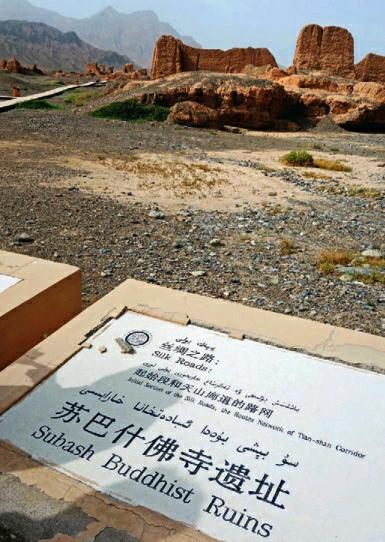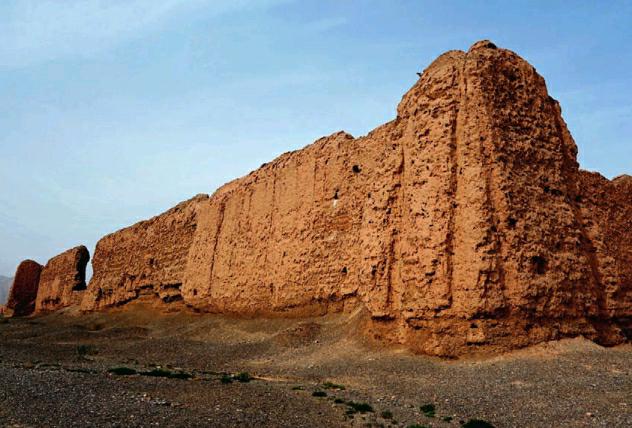World Heritage along the Silk Road
By+staff+reporter+YU+XIANGJUN
DURING the 38th session of UNESCOs World Heritage Committee in Doha, Qatar in June 2014, “Silk Roads: the Routes Network of Changan-Tianshan Corridor,” spanning from China to Kazakhstan and Kyrgyzstan, was added to UNESCOs World Heritage List. Subash Temple and five other sites became the first from Xinjiang Uygur Autonomous Region to make the list.
Past Glory
Located on a small alluvial plain by the Kucha River, the site of Subash Temple, covering about 190,000 square meters, is 20 km north of Kucha County, once the seat of the ancient kingdom of Kucha. The county sits at the southern periphery of the Tianshan Mountains and faces the Gobi Desert to the south. The Kucha River flows by, dividing the temple in two – aptly named the east and west temples. In the Uygur language, Subash means water source.
The temple was first built during the Wei-Jin Dynasties (220-420). Elite Kucha monk Kumarajiva (344-413) used to preach here. He is thought to have revolutionized Chinese Buddhism with his abundant sutra translations.
Subash Temple saw its heyday during the Tang Dynasty (618-907) when it was home to 10,000 monks and received numerous pilgrims. It welcomed legendary monk Xuanzang, who was on a journey west from the then capital Changan to an- cient India in the 630s. He stayed in Subash and preached there for over two months. In his travelogue Great Tang Records on the Western Regions, Xuanzang described the natural scenery of Subash and the endless stream of devout pilgrims who journeyed there. However, at some point during the 13th to the mid-14th centuries, the temple was abandoned.
Unoccupied for about 1,000 years, the ruins still amaze visitors. Against the backdrop of the open and vast desert, crumbling pagodas are bathed in the golden beams of sunshine. They tell us of past glory.
Example of Central Asian Earth Ruins
For about 1,000 years, Subash Temple had great signifi cance in Chinas Western Regions and played a pivotal role in cultural communication between East and West. The ruins are highly regarded for their historical, artistic, scientifi c, and social value. The temples construction utilized various typical techniques that can be seen in earthen ruins of arid Northwest China and even in Central Asia.
In the west part of the temple, quite a few Buddhist constructions still stand, including the north, west, and south walls of the main hall. The hall was about 318 meters in circumference, and encompassed a small hall inside and Buddha niches in the walls. Outside the main hall, monks dormitories and meditation rooms were situated in the west, while in the north were caves dug into the cliffside about 50 meters away where monks retreated for meditation. There are few murals inside these caves, and characters inscribed on the wall have been identifi ed as ancient Kucha. The style of these meditation caves is unique to Subash.endprint
Sixty meters west of the main hall is the most spectacular pagoda. It sits on a square base, with a slope on the south side directly leading to the second level, on which a stone pillar was erected in the center supporting the roof. This is the only place in Aksu Prefecture, where Kucha is located, where this form of pagoda can be seen. The 13.2-meter-high pagoda is the best preserved structure in the west temple.
Fusion of Eastern and Western Buddhism
In 2012, the heritage department of Kucha County, in cooperation with the School of Cultural Heritage of Northwest University, carried out an excavation of the site at Subash. They found the ruins of a pagoda in distinctive Han style, proving close relations and mutual influence between the Western Regions and the Central Plains.
The pagoda is situated at the center of the west temple beside the river. Archeologists recognized the thick eaves and pyramid shape commonly seen in Chinas inland, such as in the Giant Wild Goose Pagoda and Small Wild Goose Pagoda in Xian, whereas local Buddhist pagodas in Kucha have a characteristic upside-down bowl form, a typical Central and Southern Asia style.
Buddhism spread east from the Western Regions of China. The Han-style pagodas in Xinjiang prove that Buddhism, after integrating with Chinese characteristics of Chinas inland, returned to the Western Regions. This pagoda in Subash, built around the same period as the Tang Dynasty Giant Wild Goose Pagoda (built in 652), is just one example. However, these two pagodas differ in size and function, which confirms that Chinese Buddhism was localized in the Western Regions.
Historical records show that after reunifying the Western Regions during the Tang Dynasty, the country enjoyed a period of peace and prosperity. In 656, the emperor ordered that Kucha be made the seat of the administrative body of the west, aka the Protectorate of General to Pacify the West. Kucha was then more influenced by the Central Plains Buddhism as communication with the inland strengthened. Under this circumstance, the culture and art of Kucha Buddhism, just like the unearthed Han-style pagoda shows, integrated inland elements and developed new features.
In 1903, a Japanese exploration team led by Otani Kozui unearthed a wooden box in Subash and kept it as plunder in Tokyo National Museum. The box, made for preserving Buddhist relics, is decorated with paintings of four naked children playing instruments on the lid and a dancing picture on the side. Three years later, French archeologist Paul Pelliot carried out an excavation here and is believed to have stolen seven exquisite boxes containing Buddhist relics.
Other excavated items include Chinese coins dating from the Han Dynasty (202 BC- AD 220) to the Tang Dynasty, silver coins depicting Khosrow II of the Sassanian Persian Empire, murals, clay sculptures, and wooden slips carved with ancient ethnic characters.endprint

